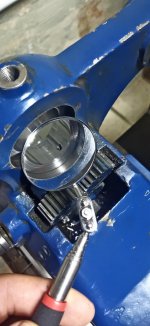Hi,
I recently purchased a Lorch & Schmidt lathe (most probably some kind of AB Type)and when I took out the spindle for mounting a serpentine belt and checked the plain bearings I noticed that there is a axial groove in the headstock bearing in which the hole from the oiler ends.
It is obviously there for distributing the oil along the entire bearing surface but should there be a felt or wick inside to hold the oil for longer and assures a constant oil film. I have done some test runs before and I was wondering how fast the oil is going through the bearing.


Thanks for the help.
Cheers
Chris
I recently purchased a Lorch & Schmidt lathe (most probably some kind of AB Type)and when I took out the spindle for mounting a serpentine belt and checked the plain bearings I noticed that there is a axial groove in the headstock bearing in which the hole from the oiler ends.
It is obviously there for distributing the oil along the entire bearing surface but should there be a felt or wick inside to hold the oil for longer and assures a constant oil film. I have done some test runs before and I was wondering how fast the oil is going through the bearing.


Thanks for the help.
Cheers
Chris



